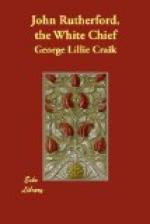In some cases, the wounds which the New Zealand women inflict on themselves are intended to express their grief for friends who have perished in war; and probably this may have been a reason for the strong exhibition of feeling in the instance just noticed by Rutherford, as the chiefs had then returned from an expedition. Such a mode of mourning has been often observed in New Zealand. During the time that Cruise was at the Bay of Islands, they found one day, upon going on shore, that a body of the natives had just returned from a war expedition, in which they had taken considerable numbers of prisoners, consisting of men, women, and children, some of the latter of whom were not two years old; and among the women was one, distinguished by her superior beauty, who sat apart from the rest upon the beach, and, though silent, seemed buried in affliction. They learned that her father, a chief of some consequence, had been killed by the man whose prisoner she now was, and who kept near her during the greater part of the day.
The officers remained on shore till the evening; “and as we were preparing to return to the ship,” continues Cruise, “we were drawn to that part of the beach where the prisoners were, by the most doleful cries and lamentations. Here was the interesting young slave in a situation that ought to have softened the heart of the most unfeeling. The man who had slain her father, having cut off his head, and preserved it by a process peculiar to these islanders, took it out of a basket, where it had hitherto been concealed, and threw it into the lap of the unhappy daughter.” At once she seized it with a degree of phrenzy not to be described; and subsequently, with a bit of sharp shell, disfigured her person in so shocking a manner that in a few minutes not a vestige of her former beauty remained. They afterwards learned that this fellow had married the very woman he had treated with such singular barbarity.
The crying, however, seems to be a ceremony that takes place universally on the meeting of friends who have been for some time parted. We may give, in illustration of this custom, Cruise’s description of the reception by their relatives of the nine New Zealanders who came along with him in the “Dromedary” from Port Jackson.
“When their fathers, brothers, etc., were admitted into the ship,” says he, “the scene exceeded description; the muskets were all laid aside, and every appearance of joy vanished. It is customary with these extraordinary people to go through the same ceremony upon meeting as upon taking leave of their friends. They join their noses together, and remain in this position for at least half-an-hour;[P] during which time they sob and howl in the most doleful manner. If there be many friends gathered around the person who has returned, the nearest relation takes possession of his nose, while the others hang upon his arms, shoulders, and legs, and keep perfect time with the chief mourner




